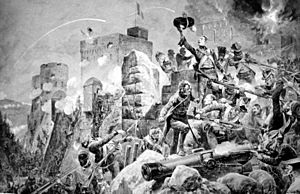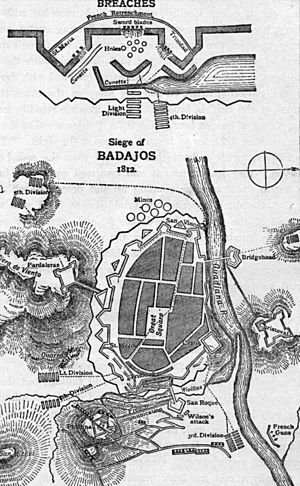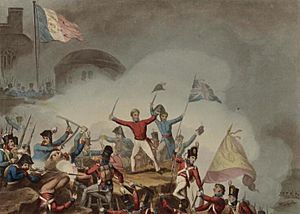Siege of Badajoz (1812) facts for kids
Quick facts for kids Siege of Badajoz (1812) |
|||||||
|---|---|---|---|---|---|---|---|
| Part of the Peninsular War | |||||||
 "The Devil's Own" 88th Regiment at the Siege of Badajoz, by Richard Caton Woodville |
|||||||
|
|||||||
| Belligerents | |||||||
| Commanders and leaders | |||||||
| Strength | |||||||
| 4,742–5,000 | 27,000 52 guns |
||||||
| Casualties and losses | |||||||
| 1,300–1,500 killed or wounded 3,500–3,700 captured |
4,760–4,924 killed or wounded | ||||||
| 200–4,000 Spanish civilians killed or injured | |||||||
The Siege of Badajoz was a major battle during the Peninsular War in 1812. It took place from March 16 to April 6, 1812. An army of British and Portuguese soldiers, led by Arthur Wellesley (who later became the Duke of Wellington), attacked the city of Badajoz in Spain. The city was defended by French soldiers.
This siege was one of the toughest and most costly battles of the Napoleonic Wars. Many soldiers were hurt or lost their lives. After the city was captured, some soldiers acted badly. It took several days for order to be fully restored.
Contents
Why the Siege of Badajoz Happened
The Peninsular War was a big conflict in Europe. The British and Portuguese armies wanted to push the French out of Spain. To do this, they needed to control important towns. Badajoz was a key city because it helped protect the supply routes to Lisbon, Portugal. Lisbon was the main base for the Allied army.
The French had a strong army of about 5,000 soldiers in Badajoz. Their leader was General Armand Philippon. The city had very strong walls and defenses. It had already survived two attacks before this one. The French had made the walls even stronger. They also set up traps like flooded areas and hidden explosives.
Starting the Attack on Badajoz
The Allied army had about 27,000 soldiers. This meant they had about five times more soldiers than the French. On March 17, 1812, they surrounded Badajoz. The soldiers began digging trenches and earthworks. These were needed to protect their large artillery guns.
The work was very hard because of heavy rain. The rain made the ground muddy and washed away bridges. These bridges were needed to bring up the heavy cannons.
First Fights and Capturing Fort Picurina
On March 19, the French soldiers made a surprise attack. About 1,500 men rushed out and caused some damage to the Allied workers. They were eventually pushed back.
By March 25, the Allied cannons began firing at a small fort outside the city called Fort Picurina. That night, 500 British soldiers attacked and captured the fort. It was a tough fight, and many soldiers were hurt. But taking the fort was important. It allowed the Allies to dig more trenches closer to the city walls.
Heavy cannons arrived, and they started to blast holes in the city's defenses. On March 31, the Allies began a very strong bombardment. They kept firing at the stone walls.
By April 5, two large holes, called breaches, were made in the main wall. The soldiers got ready to storm the city. The attack was delayed for a day to make a third breach. News came that French General Marshal Soult was coming to help Badajoz. So, the attack was ordered for 10:00 PM on April 6.
The French knew the attack was coming. They quickly set up traps in the breaches. They used sharp objects, spiked barriers, and even barrels of gunpowder to stop the attackers.
The Final Attack
With three big holes in the wall, Wellington ordered his troops to attack. At 10:00 PM on April 6, the soldiers moved forward. They carried ladders and tools.
There were three main attacks:
- The first soldiers to attack the breaches were called the "forlorn hope." They led the main attack by the 4th Division.
- Another group, Alten's Light Division, attacked the third breach.
- Other British and Portuguese soldiers made smaller attacks. Some, from Picton's 3rd Division, attacked the Castle.
As the first attackers moved, a French guard saw them and raised the alarm. Suddenly, French soldiers appeared on the walls. They fired their muskets and threw grenades and stones. They even rolled barrels of gunpowder down.
The fighting was very intense. Many British and Portuguese soldiers were hurt or lost their lives at the walls. The breaches became filled with fallen soldiers. Despite the danger, the Allied soldiers kept pushing forward. But the French defenders were strong. In less than two hours, about 2,000 Allied soldiers were killed or badly wounded at the main breach.
Picton's 3rd Division managed to climb the castle wall. General Picton himself was wounded while climbing. Once inside the castle, they were safe. But they couldn't immediately help the other divisions because the entrances were blocked.
Wellington was about to stop the attack because of the heavy losses. But then he heard that his soldiers had gotten into the castle. He ordered the castle gates to be blown open. This allowed the 3rd Division to help the other attacks.
The 5th Division also attacked another part of the wall. They lost 600 men but finally reached the top. Major Lord FitzRoy Somerset was one of the first to enter. He helped open a gate for more British soldiers.
The city's fate was sealed when the 3rd and 5th Divisions joined up inside the town. The British and Portuguese soldiers now had a strong position. General Philippon, seeing he could not win, moved his soldiers to a nearby fort. He surrendered shortly after the city fell.
When the sun rose on April 7, it showed the terrible scene. Many bodies were piled up, and the ditches were full of blood. Wellington was very sad to see so many British soldiers lost. The attack and earlier fights had caused about 4,800 Allied casualties. The Light Division, a skilled group, lost about 40% of its soldiers.
After the Battle
After the city was captured, some soldiers behaved badly. It took about three days for military order to be fully restored. Some soldiers were punished.
Historians have studied what happened to the people of Badajoz. Records show that about 300 families, or 1,200 to 1,500 people, had stayed in the city. A local priest recorded a list of civilians who were hurt or lost their lives. It's thought that between 250 and 280 civilians were killed or injured. This means about 20% to 30% of the civilians living near the walls were affected.
From a military engineering point of view, the quick attack led to more casualties. There wasn't enough time for careful planning. This siege later led to the creation of the Royal School of Military Engineering. This school helped train engineers to build better siege works.
After this victory, Wellington moved his army further into Spain. This led to more battles, like the Battle of Salamanca, as the Peninsular War continued.
See also
 In Spanish: Batalla de Badajoz (1812) para niños
In Spanish: Batalla de Badajoz (1812) para niños
- Badajoz bastioned enclosure
Images for kids





